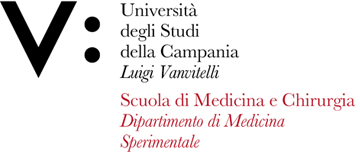Salvatore D'AMATO
Insegnamento di CHIRURGIA MAXILLO-FACCIALE
Corso di laurea magistrale a ciclo unico in MEDICINA E CHIRURGIA (Sede di Napoli)
SSD: MED/29
CFU: 1,00
ORE PER UNITÀ DIDATTICA: 10,00
Periodo di Erogazione: Primo Semestre
Italiano
| Lingua di insegnamento | Italiano |
| Contenuti | Anatomia ed embriologia del Distretto Cranio-Maxillo-Cervico-Facciale
- Semeiotica clinica e strumentale Cranio-Maxillo-Cervico-Facciale
- Malformazioni congenite Cranio-Maxillo-Cervico-Facciali
Prevenzione delle patologie del distretto orale
- Patologia dell’anello linfatico del Waldayer
- Malattia focale
- Patologia infiammatoria delle mucose delle vie aereo-digestive superiori
- Lesioni precancerose delle vie aereo digestive superiori
- Neoplasie benigne e maligne delle vie aereo-digestive superiori
- Patologie delle ghiandole salivari
- Tumefazioni del collo
- Malattie dell’articolazione temporo-mandibolare
- Malattie displastiche dei mascellari
- Nevralgie trigeminali
- Paralisi del nervo faciale, ricorrenziale e non, ipoglosso
- Osteopatie
- Traumatologia del distretto cervico-facciale
- Disfonia funzionale e dislalia
-Emergenze in Chirurgia Maxillo-Facciale |
| Testi di riferimento | La chirurgia Orale e maxillo-facciale moderna- Antonio Delfino Editore |
| Obiettivi formativi | Il corso ha l’obiettivo di introdurre lo studente alla conoscenza sia della clinica e che delle tecniche di chirurgia delle patologie di interesse chirurgico del distretto cranio-maxillo-facciale, vertendo sull’esordio, sull’evoluzione e sul trattamento delle stesse, sul management del paziente e delle complicanze peri e postoperatorie. Il corso mediante lezioni frontali consentirà allo studente di ottenere l’acquisizione delle nozioni teoriche della materia, con input verso la pratica clinica e chirurgica mettendo alla luce gli aspetti salienti della stessa mediante attualizzazione dello state-of-art della disciplina.
Al termine del corso lo studente dovrà padroneggiare gli aspetti teorico-pratici della patologia chirurgica del distretto cranio maxillo facciale, delle nozioni cardine delle stesse all’inquadramento del paziente fino all’approccio terapeutico e quindi delle tecniche chirurgiche illustrate |
| Prerequisiti | E’ essenziale che lo studente abbia già acquisito, nel corso del suo percorso formativo precedente, ottima metodologia di studio e la conoscenza dei fondamenti della semeiotica clinica e chirurgica nonché delle discipline propedeutiche in toto. |
| Metodologie didattiche | Il corso si basa su lezioni frontali interattive mediante l’ausilio di slides o di presentazioni informatiche ai fini di un targetting dello verso i topic preposti nell’ottica di partecipazione attiva degli studenti per una metodica di apprendimento smart e dinamica |
| Metodi di valutazione | Si otterrà la verifica mediante esame orale che deve essere sostenuto dagli studenti dinanzi alla commissione dei docenti che hanno tenuto il corso stesso. Il fine dell’esame sarà la valutazione sia delle conoscenze acquisite alla luce degli insegnamenti preposti seguendo il programma delineato sia della capacità critica e diagnostica dello studente sviluppata al termine del percorso formativo |
| Altre informazioni | Il corso sarà svolto nell’ambito del Corso di Laurea Magistrale in Medicina e Chirurgia |
| Programma del corso | Traumatologia: |
English
| Teaching language | italian |
| Contents | Anatomy and embryology of the Cranio-Maxillo-Cervico-Facial District
- Cranio-Maxillo-Cervico-Facial clinical and instrumental Semeiotics
- Cranio-Maxillo-Cervico-Facial congenital malformations
Prevention of diseases of the oral district
- Pathology of the Waldayer lymphatic ring
- Focal disease
- Inflammatory pathology of the mucous membranes of the upper air-digestive pathways
- Precancerous injuries of upper digestive airways
- Benign and malignant neoplasms of the upper air-digestive pathways
- Disorders of the salivary glands
- Neck swelling
- Diseases of the temporo-mandibular agriculture age
- Dysplastic diseases of the jaws
- Trigeminal neuralgia
- Paralysis of the facial nerve, recurrent and not, hypoglossal
- Osteopathies
- Traumatology of the cervico-facial district
- Functional dysphonia and dyslonia
Emergencies in Maxillofacial Surgery |
| Textbook and course materials | Modern oral and maxillofacial surgery - Antonio Delfino Editore |
| Course objectives | The course aims to introduce the student to the clinic and surgery of diseases of surgical interest in the cranio-maxillo-facial district, from the onset to evolution and then to treatment as well as to management before and after surgery with notes of surgical technique and management of peri and postoperative complications. The course will allow the student to visualize in the clinical and surgical practice what has been learned from the lectures, being able to deepen with the tutors the main aspects of the same through the activities of the department and operating room.
At the end of the course the student must possess the mastery of the semiotics of the cranio maxillo facial area, both clinical and surgical, in front of the proposed cases, through surgical steps as well as the variations of the technique itself and of the expected outcomes. |
| Prerequisites | During of his previous training, it is essential that the student has already acquired the basics of surgical semeiotics as well as the theoretical notions of the cranio-maxillofacial surgical pathology |
| Teaching methods | The course is based on interactive lectures through the use of slides or computer presentations for the purpose of a targetting to the topics with the aim of an active participation of students in a smart and dynamic learning method. |
| Evaluation methods | It will be obtained the verification by oral examination that must be supported by the students in front of the commission of the teachers who held the course itself. The end of the exam will be the evaluation of both the knowledge acquired in the light of the courses in charge following the program outlined and the critical and diagnostic capacity of the student developed at the end of the training course |
| Other information | The course will be held as part of the Degree Program |
| Course Syllabus | Traumatology: |








